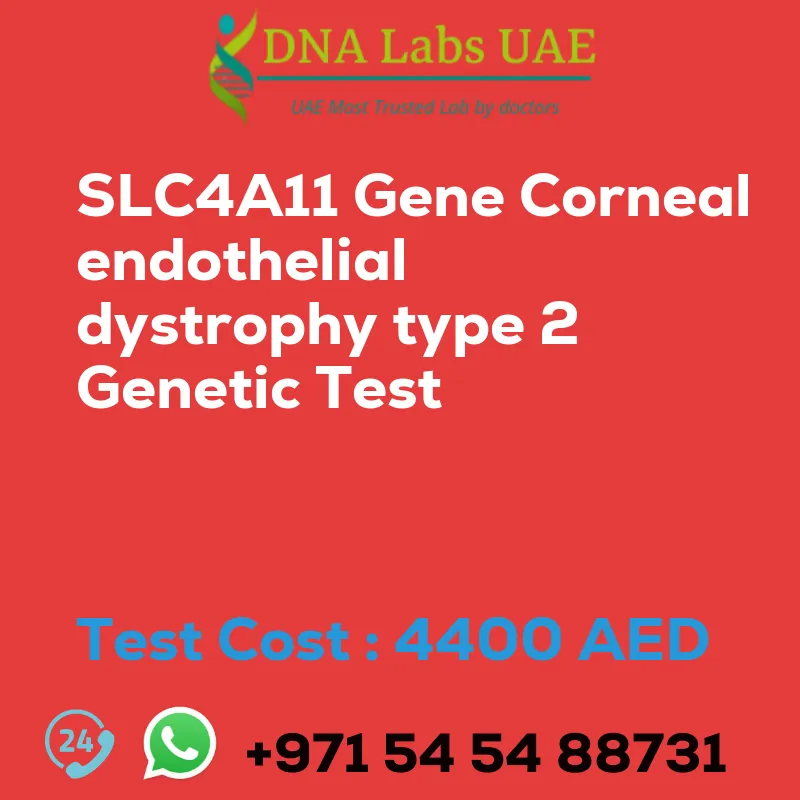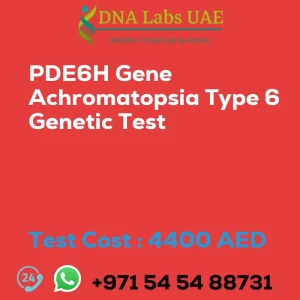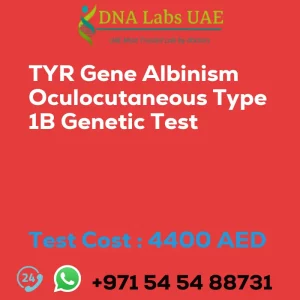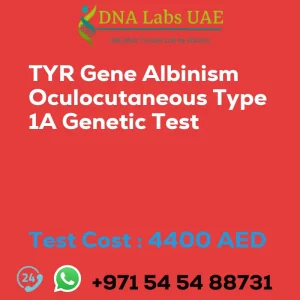SLC4A11 Gene Corneal Endothelial Dystrophy Type 2 Genetic Test
Overview
The SLC4A11 gene is associated with corneal endothelial dystrophy type 2, a rare inherited disorder that affects the cornea. This disorder leads to malfunctioning of the corneal endothelial cells, resulting in clouding and decreased vision.
Genetic Test Details
The SLC4A11 Gene Corneal Endothelial Dystrophy Type 2 Genetic Test is available at DNA Labs UAE. The test utilizes NGS (next-generation sequencing) technology to analyze multiple genes simultaneously, providing a comprehensive assessment of genetic variants associated with the disorder.
Test Components and Price
- Test Name: SLC4A11 Gene Corneal Endothelial Dystrophy Type 2 Genetic Test
- Components: Blood or Extracted DNA or One drop Blood on FTA Card
- Price: 4400.0 AED
Sample Condition
The test requires a blood sample, extracted DNA, or one drop of blood on an FTA card.
Report Delivery
The test results are typically delivered within 3 to 4 weeks.
Method
The test utilizes NGS (next-generation sequencing) technology for analysis.
Test Type
The SLC4A11 Gene Corneal Endothelial Dystrophy Type 2 Genetic Test falls under the category of Ophthalmology Disorders.
Doctor and Test Department
The test is conducted by an Ophthalmologist in the Genetics department.
Pre Test Information
Prior to the test, it is important to provide the clinical history of the patient who is undergoing the SLC4A11 Gene Corneal Endothelial Dystrophy Type 2 NGS Genetic DNA Test. A Genetic Counselling session is recommended to draw a pedigree chart of family members affected by the disorder.
Test Usage
The SLC4A11 Gene Corneal Endothelial Dystrophy Type 2 Genetic Test is useful for individuals with a family history of the disorder or those experiencing symptoms such as blurred vision or glare. It can also be used for carrier screening in individuals planning to have children.
Important Considerations
While genetic testing provides valuable information about the likelihood of developing a disorder, it cannot predict the severity or progression of the disorder. It is essential to interpret genetic testing results alongside other clinical and diagnostic information.
| Test Name | SLC4A11 Gene Corneal endothelial dystrophy type 2 Genetic Test |
|---|---|
| Components | |
| Price | 4400.0 AED |
| Sample Condition | Blood or Extracted DNA or One drop Blood on FTA Card |
| Report Delivery | 3 to 4 Weeks |
| Method | NGS Technology |
| Test type | Ophthalmology Disorders |
| Doctor | Ophthalmologist |
| Test Department: | Genetics |
| Pre Test Information | Clinical History of Patient who is going for SLC4A11 Gene Corneal endothelial dystrophy type 2 NGS Genetic DNA Test. A Genetic Counselling session to draw a pedigree chart of family members affected with SLC4A11 Gene Corneal endothelial dystrophy type 2 NGS Genetic DNA Test gene SLC4A11 |
| Test Details |
The SLC4A11 gene is associated with corneal endothelial dystrophy type 2, which is a rare inherited disorder that affects the cornea. This disorder causes the corneal endothelial cells to malfunction, leading to clouding and decreased vision. NGS (next-generation sequencing) genetic testing can be used to identify mutations in the SLC4A11 gene, which can confirm a diagnosis of corneal endothelial dystrophy type 2. This type of genetic testing involves analyzing multiple genes at once, allowing for a more comprehensive assessment of genetic variants that may be contributing to the disorder. NGS genetic testing for corneal endothelial dystrophy type 2 can be useful for individuals who have a family history of the disorder or who are experiencing symptoms such as blurred vision or glare. This type of testing can also be used for carrier screening in individuals with a family history of the disorder who are considering having children. It is important to note that while genetic testing can provide valuable information about the likelihood of developing a disorder, it cannot predict the severity or progression of the disorder. Additionally, genetic testing results should be interpreted in conjunction with other clinical and diagnostic information. |








